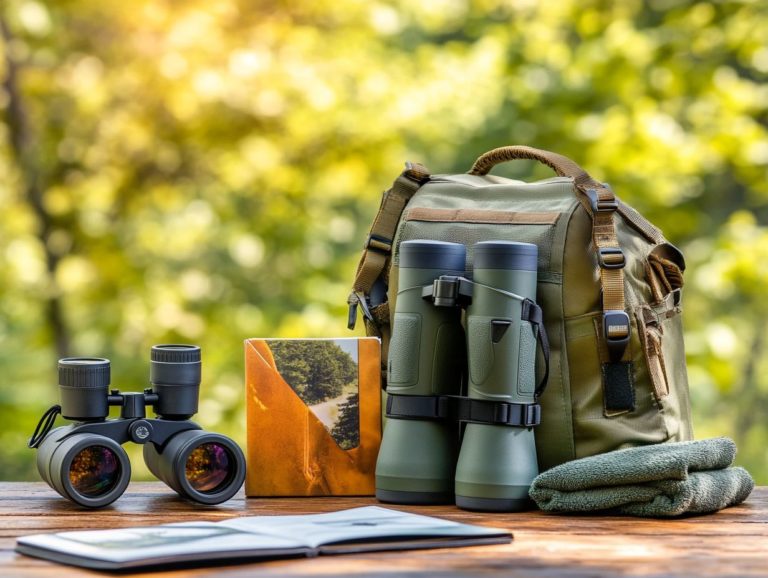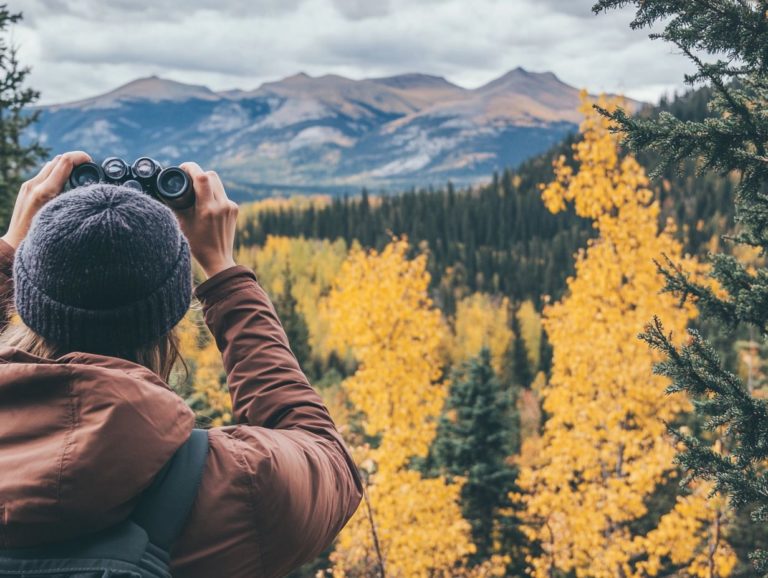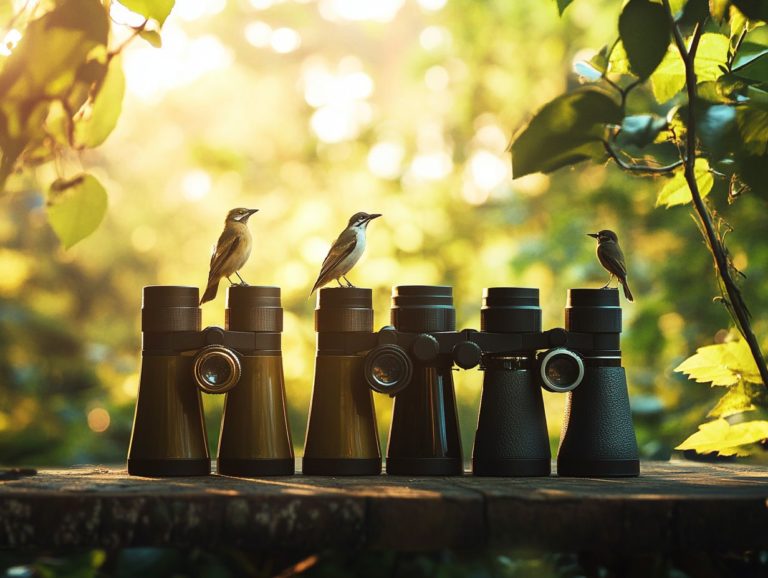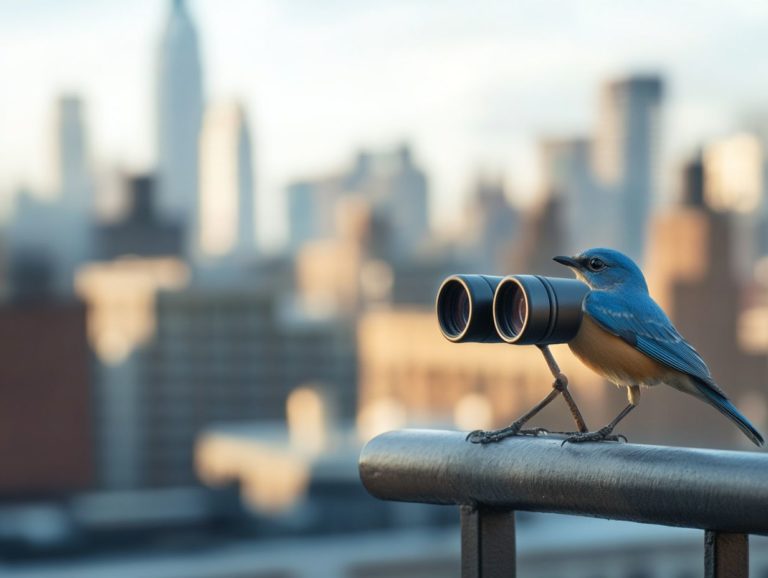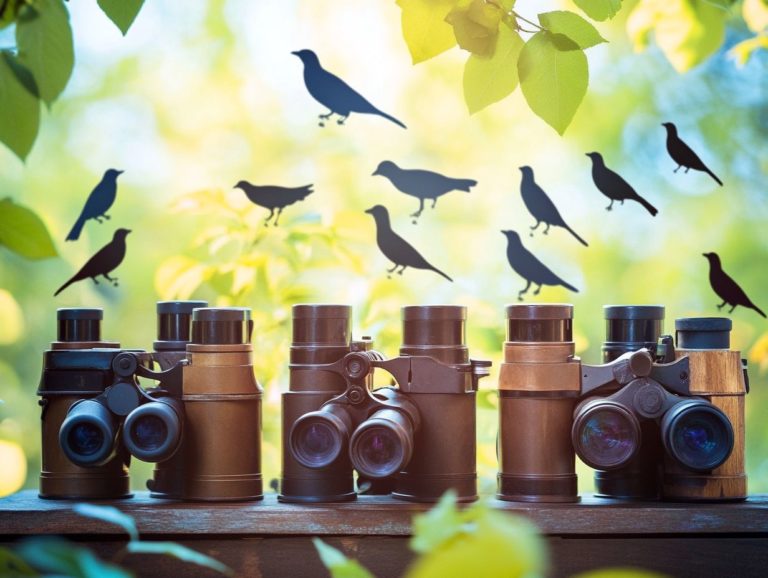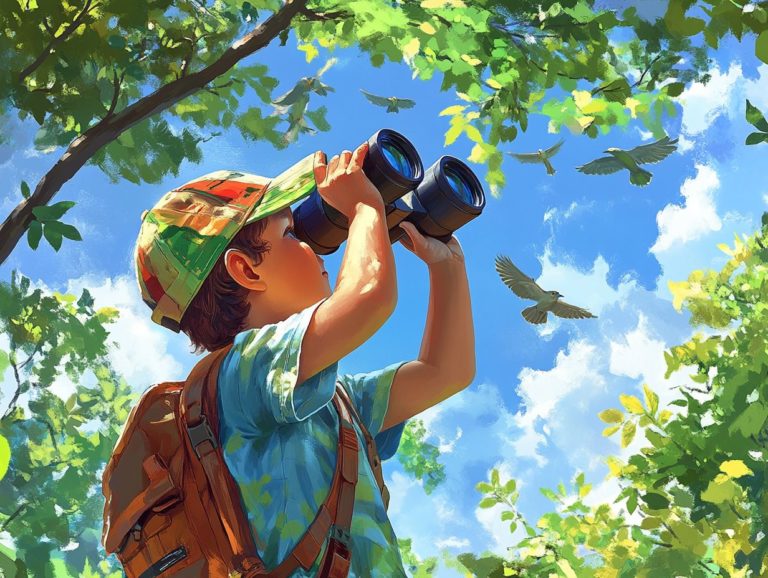A Guide to Choosing Binoculars for Wildlife Viewing
Wildlife viewing can be an exhilarating experience! It offers you a unique glimpse into the lives of animals in their natural habitats.
To truly enhance this adventure, having the right binoculars is essential. This guide will walk you through the critical factors to consider when selecting binoculars, including magnification, lens size, weight, and comfort.
You’ll explore different types of binoculars, practical tips for using them effectively in the field, and learn how to protect your investment. Whether you re a seasoned birdwatcher or a curious nature lover, this guide equips you with the knowledge to make the most of your wildlife observations.
Contents
- Key Takeaways:
- Factors to Consider when Choosing Binoculars
- Types of Binoculars for Wildlife Viewing
- Tips for Using Binoculars in the Field
- Frequently Asked Questions
- What are some important factors to consider when choosing binoculars for wildlife viewing?
- What is the recommended magnification for binoculars used for wildlife viewing?
- Should I choose binoculars with a larger or smaller objective lens for wildlife viewing?
- What is the importance of field of view when choosing binoculars for wildlife viewing?
- What type of lens coating should I look for when choosing binoculars for wildlife viewing?
- What other features should I consider when choosing binoculars for wildlife viewing?
Key Takeaways:
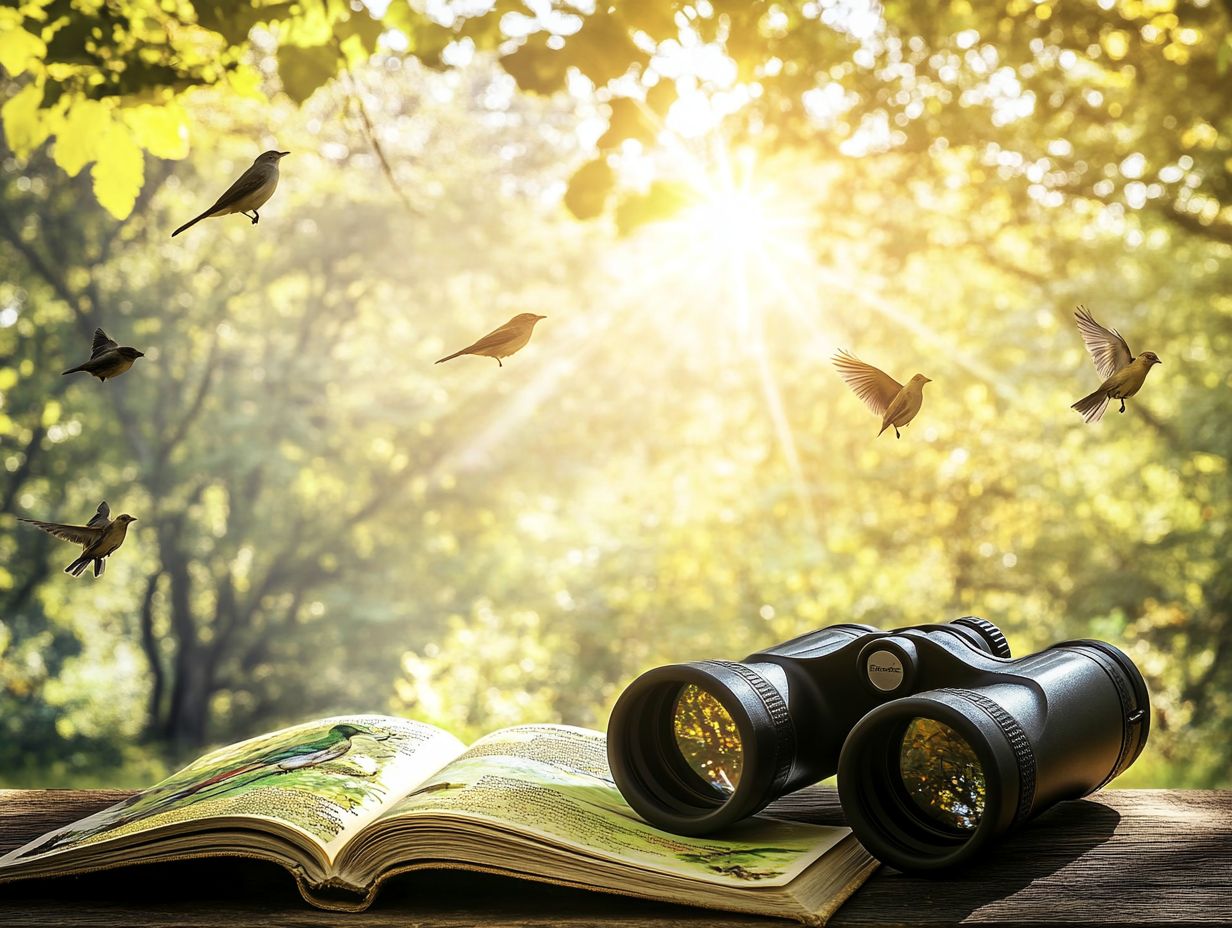
- Consider magnification and lens size for a clear and detailed view of wildlife.
- Choose a waterproof and durable binocular for tough outdoor conditions.
- Use proper technique and adjustments, and visit wildlife viewing areas during the best times for optimal viewing.
Benefits of Using Binoculars for Wildlife Viewing
Using binoculars for wildlife viewing dramatically enhances your experience! You’ll observe birds and creatures in their natural habitats with incredible clarity, especially when you know how to pick binoculars for birding tours.
The high-quality optics provide you with unparalleled detail, allowing you to appreciate the vibrant colors and intricate features of wildlife that are often overlooked by the naked eye. Whether you’re catching sight of a majestic eagle soaring through the sky or trying to spot a small sparrow blending into the foliage, the ability to observe at varying distances makes all the difference.
When tracking migratory birds or spotting elusive mammals, binoculars become your best ally! For kids, knowing how to choose binoculars for kids’ bird watching is essential. Lightweight models with ergonomic grips reduce fatigue, letting you enjoy longer viewing sessions and deepen your connection with nature.
Factors to Consider when Choosing Binoculars
Choosing the right binoculars involves several critical factors that can significantly enhance your birdwatching and wildlife viewing experiences. Pay attention to specifications such as magnification, lens size, and field of view to find binoculars that align with your interests. For detailed insights, check out this guide on how to select binoculars for bird watching tours, whether that’s stargazing or observing wildlife up close.
Performance ratings from expert reviews and user feedback serve as your compass, guiding you through various reputable brands like Nikon, Canon, and Celestron. This helps you discover budget-friendly options without sacrificing image quality or optical performance.
Consider accessories like a binocular harness and neck strap to enhance your time in nature, making your outdoor adventures even more enjoyable.
Magnification and Lens Size
Magnification and lens size are critical elements that significantly influence the clarity and sharpness of the images you observe through binoculars. A higher magnification lets you zoom in on distant subjects whether they are birds flitting through the trees or celestial wonders in the night sky. Lens size is vital for light transmission and overall optical performance.
Larger lenses typically gather more light, enhancing clarity in low-light conditions. This makes them perfect for both early morning birdwatching and nighttime stargazing. It s essential to find a balance between these features and considerations of portability, especially for extended outdoor use.
The relationship between magnification and lens size can greatly elevate your viewing experience, but it comes with its trade-offs. While higher magnification might seem like a ticket to more detail, it can lead to a dimmer image if the lens size isn t increased accordingly. Think about how light transmission affects your viewing conditions; pairing lower magnification with a larger lens can yield a brighter and sharper image, particularly beneficial in less-than-ideal lighting.
Understanding these subtleties can enhance your experience and usability when selecting binoculars for specific activities like wildlife observation or how to choose a camera for bird watching.
Field of View and Close Focus
The field of view refers to how much of the scenery you can see through your binoculars at once. This capability is essential for enhancing your wildlife viewing experience. A wider field of view allows you to track fast-moving animals easily, making your outings enjoyable and fulfilling.
The close focus feature enables you to observe intricate details at short distances. This is crucial for those unforgettable wildlife moments or even leisurely stargazing.
When selecting binoculars, understanding how these specifications work together helps you choose a model that aligns with your viewing scenarios and preferences.
These features make your outdoor adventures exciting and memorable, whether you re marveling at migratory birds across vast landscapes or examining delicate butterfly patterns nearby. With a superior field of view, you can effortlessly track unpredictable wildlife movements without losing sight of the action.
Moreover, the ability to focus closely helps you appreciate the finer details that often go unnoticed. The right binoculars can turn any outing into an unforgettable adventure, immersing you fully in the sights and sounds of the natural world.
Weight and Comfort
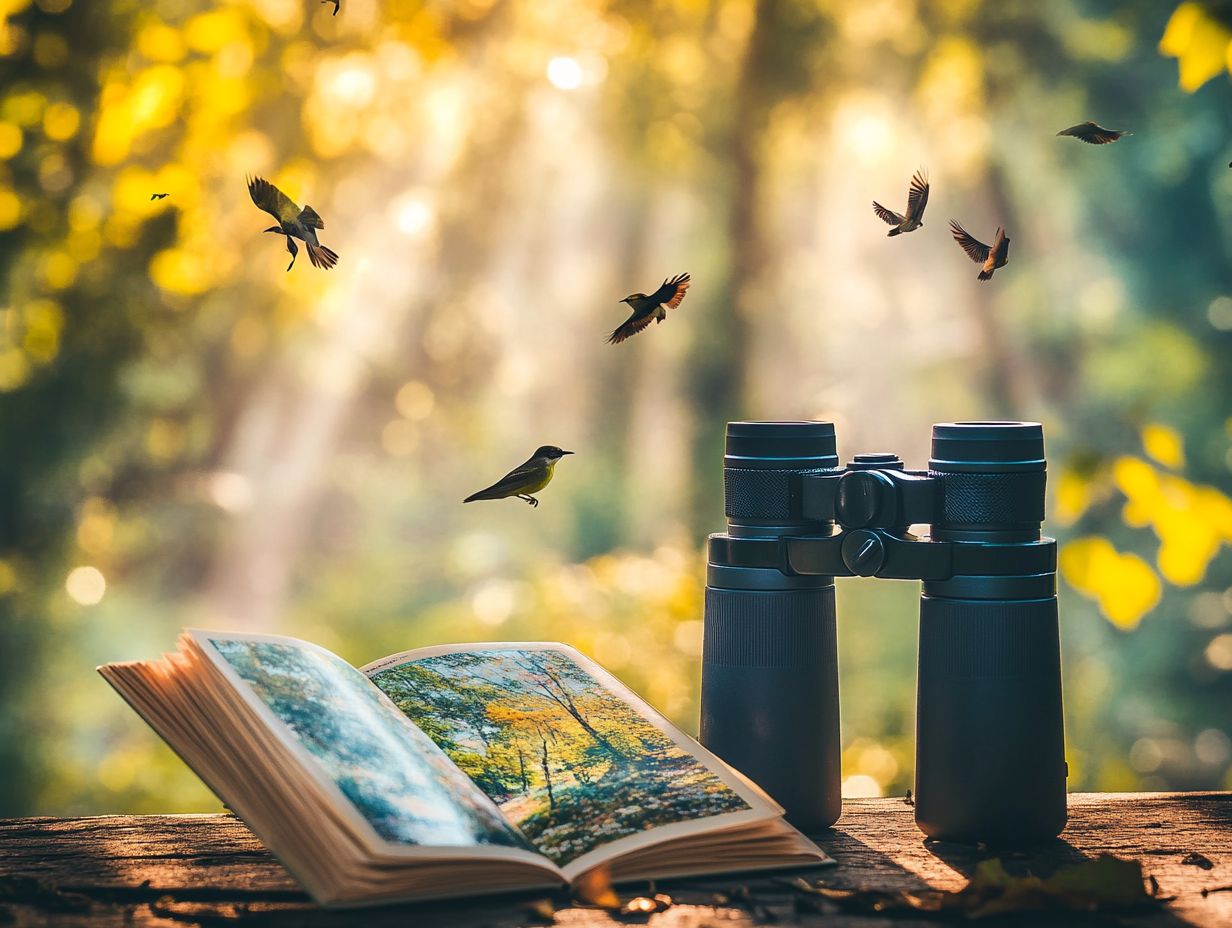
Weight and comfort are often underestimated yet crucial factors when selecting binoculars for extended wildlife observation adventures. For those interested in birding, knowing what to look for when buying birding binoculars can make a significant difference. A well-balanced pair with effective weight distribution allows for long viewing sessions without strain.
Look for comfortable design features like textured grips and adjustable eyecups. These can greatly enhance your overall experience, making it easier to focus during various outdoor activities.
It’s essential to try different models to find one that feels right, especially if you plan to carry them for lengthy birdwatching excursions or stargazing nights.
During activities, you could find yourself on your feet for hours, scanning the horizon for elusive creatures. If your binoculars are heavier than necessary, you might experience arm fatigue, leading to missed wildlife moments.
In scenarios like hiking or camping, portability is a game-changer. Compact and lightweight models can slip into your backpack effortlessly without weighing you down.
The right balance of weight management and ergonomic features ensures comfort while enhancing overall performance. This allows you to immerse yourself in nature without the distraction of discomfort.
Waterproof and Durability
Waterproofing and durability are crucial when selecting binoculars, especially for outdoor enthusiasts engaged in birdwatching or wildlife observation in diverse weather conditions. Waterproof binoculars provide invaluable peace of mind during unexpected rain showers, ensuring your equipment remains functional.
A durable construction adds longevity, making your binoculars resilient against drops and rough handling. Whether you re attending an Audubon Convention or venturing into the wilderness, recognizing the significance of these features greatly enhances your outdoor experience and safeguards your investment.
Imagine spotting a rare bird while hiking through a misty forest, only to have your binoculars fog up due to sudden downpours. In such moments, having binoculars designed to withstand the elements is not just convenient but an absolute necessity.
For those indulging in activities like kayaking or going on safari tours, the risk of splashes or drops is always present. Durable and waterproof binoculars alleviate worries and let you fully immerse yourself in nature, whether observing elusive wildlife or soaking in breathtaking landscapes.
Types of Binoculars for Wildlife Viewing
Understanding the various types of binoculars available for wildlife viewing can profoundly enhance your experience and effectiveness in observing nature. The two primary designs, Porro prism and roof prism, each bring unique advantages in terms of optical performance and portability.
For instance, while Porro prism binoculars often provide better image quality and a wider field of view, roof prism models are renowned for their compact design, making them easy to carry during outdoor adventures. By selecting the right type to suit your needs be it birdwatching or stargazing you can ensure a far more gratifying wildlife viewing experience.
Porro Prism vs Roof Prism
When selecting binoculars, understanding the differences between Porro prism and roof prism designs is crucial for achieving best performance.
Porro prism models excel in providing superior depth perception and a richer viewing experience. However, their larger size can be cumbersome if you re frequently on the go.
If you often find yourself navigating through dense forests or scaling mountains, you might appreciate the lightweight nature of roof prism binoculars. They easily slip into a backpack or rest comfortably in your hands for extended periods.
Not only does the roof prism design enhance portability, but it also boasts a more streamlined aesthetic. This is perfect for photographers who wish to capture wildlife moments without drawing too much attention. Ultimately, whether you prioritize advanced optical quality or practicality in design, each type of binocular offers distinct advantages tailored to various wildlife observation scenarios.
Compact vs Full-size
When deciding between compact and full-size binoculars, weigh both portability and user experience. This is especially important if you’re an avid birdwatcher or wildlife enthusiast. To help you choose the right option, refer to our guide on how to evaluate binoculars for bird watching.
Compact binoculars shine in their convenience, making it easy for you to switch from serene nature trails to bustling urban parks. However, they might not deliver the level of detail you crave for distant observations.
On the other hand, full-size models, while bulkier and heavier, offer the chance to appreciate intricate feather patterns and vibrant colors in a bird’s plumage. This makes them a superior choice for those serious about wildlife watching.
Each option has its exciting pros and cons that you need to explore! Finding the right balance between usability and optical performance often hinges on your personal preferences, like how frequently you travel or how long you plan to engage in viewing sessions.
Ultimately, determining whether you prioritize ease of transport or the richness of vision will guide your choice for your specific outdoor adventures.
Tips for Using Binoculars in the Field
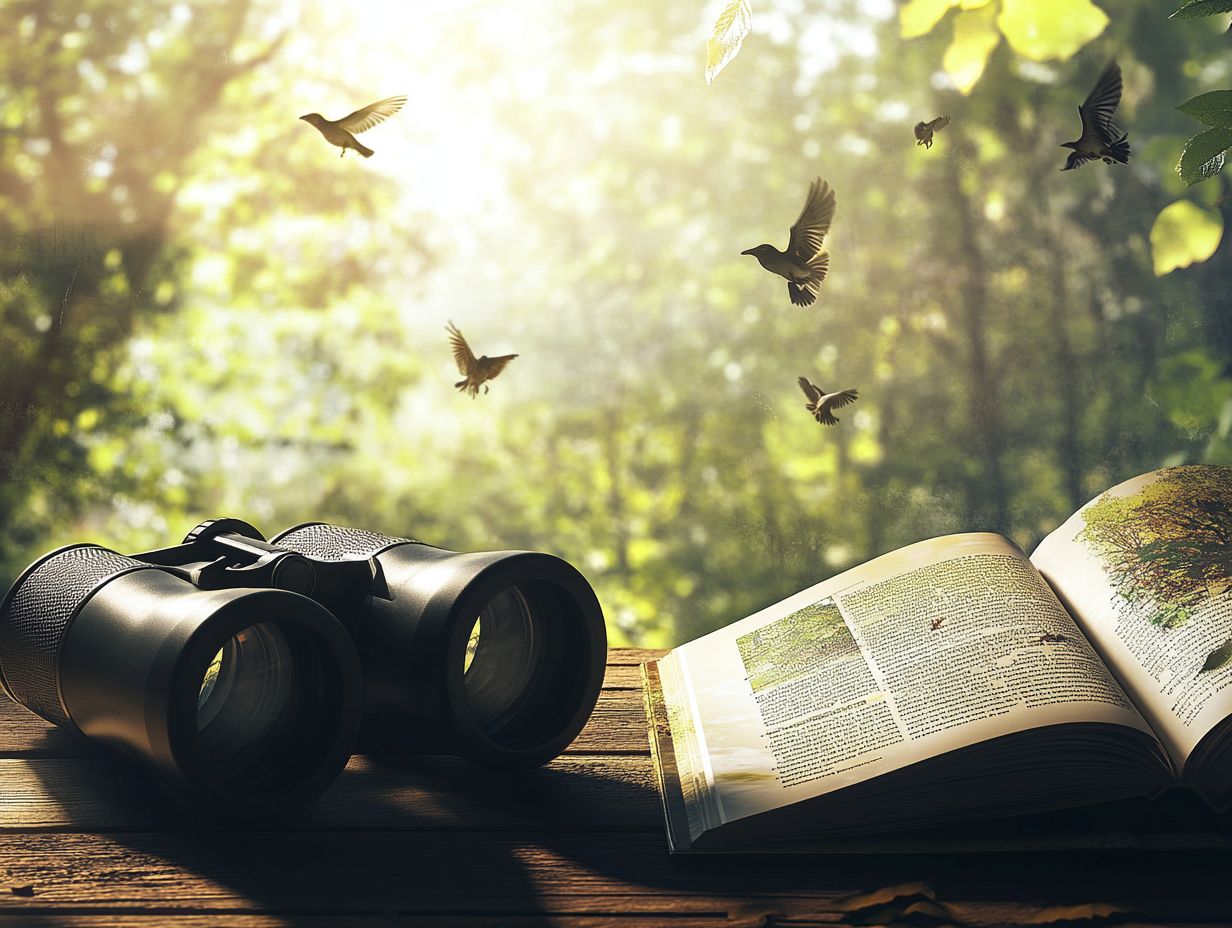
Using binoculars effectively in the field involves honing your skills and employing a few key techniques that can elevate your wildlife viewing experience. Mastering the proper methods for holding and adjusting your binoculars can enhance clarity and reduce fatigue during long hours of observation.
For example, skillfully utilizing the focus wheel and adjusting the diopter the adjustment to correct differences in vision between your two eyes can profoundly influence your ability to see the intricate details of wildlife. Familiarize yourself with your binoculars before heading out to ensure you re ready for the dynamic challenges of outdoor activities like birdwatching or stargazing.
Proper Technique and Adjustments
Mastering proper technique and making necessary adjustments can truly elevate your binocular viewing experience in the field.
For a stable view, grip your binoculars with both hands. Rest your elbows on a solid surface or your knees for support. This approach minimizes movement, allowing for clearer images even at long distances.
Once you ve got the right hold, the focus wheel becomes your best friend. It enables you to adjust the visual clarity based on how far away your subject is. The diopter adjustment is equally important, ensuring that any discrepancies between your eyes are balanced, which prevents strain during extended observation sessions.
Comfortable eyecups can be a game changer, especially if you wear glasses. They provide a better fit and ensure you get the full field of view, enriching your overall experience.
Best Times for Wildlife Viewing
Understanding the prime times for wildlife viewing can significantly enhance your birdwatching and stargazing experiences, so you can catch animals at their most lively. Early mornings and late afternoons are typically the golden hours for spotting birds, as many species are foraging and socializing during these times.
Stargazing is best enjoyed away from city lights on clear nights, especially around new moons when the sky is at its darkest. By timing your outdoor activities with these natural patterns, you ll uncover breathtaking sights you won t want to miss!
In those early mornings, the soft light enhances your view, while the crisp air stirs wildlife into vibrant activity. You might find yourself enchanted by a flock of warblers flitting about, their colors popping against the morning horizon.
As the day winds down, late afternoons reveal dramatic interactions within animal communities, showcasing unique behaviors that captivate the observer.
For those passionate about stargazing, weekends often attract larger crowds. Opting for a mid-week adventure can grant you a quieter atmosphere, perfect for uninterrupted contemplation of the cosmos.
By aligning your schedule with the best times, you deepen your connection with nature and open the door to unforgettable encounters and cosmic reflections.
Protecting Your Binoculars
Protecting your binoculars is essential for ensuring their long-lasting quality and maintaining peak performance during your outdoor adventures. Accessories like a binocular harness, neck strap, and lens covers act as a shield against dirt, moisture, and those unfortunate accidental drops.
Choosing weatherproof binoculars adds an extra layer of security against unpredictable conditions, ensuring your gear remains functional no matter what Mother Nature throws your way. Regular maintenance and proper storage techniques enhance durability, allowing you to fully savor your wildlife viewing or stargazing escapades for years to come.
Incorporating these protective measures not only safeguards your investment in high-quality equipment but also elevates your overall experience while using them. For example, lens cleaning solutions and microfiber cloths efficiently banish smudges or fingerprints, delivering those clear, crisp images you crave.
When transporting your binoculars, consider utilizing padded cases or backpacks specifically designed for them. This minimizes the risk of damage on the go. By being proactive with both accessories and routine care, you can ensure your binoculars stay in peak condition, ready for every adventure that awaits in the great outdoors.
Frequently Asked Questions
What are some important factors to consider when choosing binoculars for wildlife viewing?
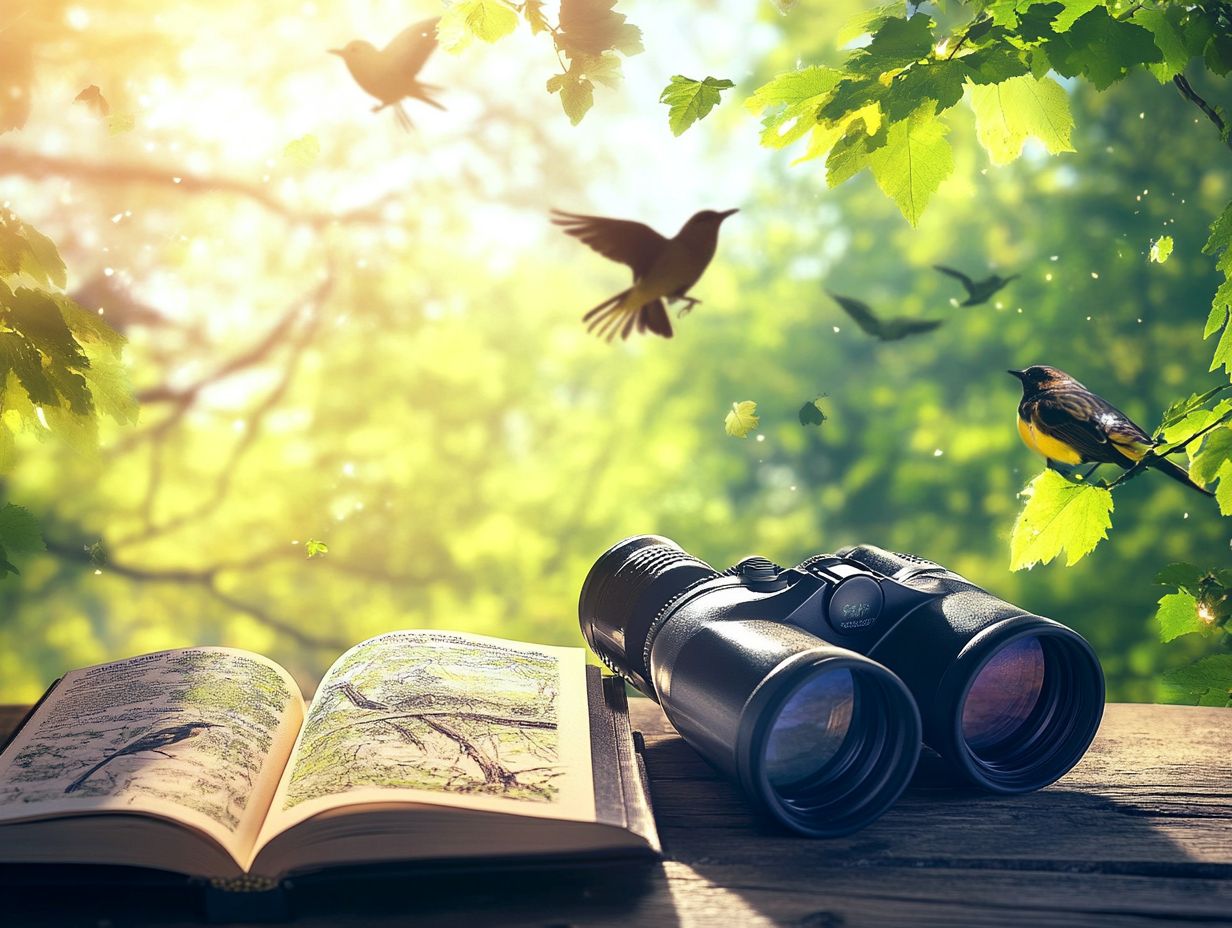
Some important factors to consider include magnification, objective lens size, field of view, and lens coating.
What is the recommended magnification for binoculars used for wildlife viewing?
The recommended magnification for binoculars used for wildlife viewing is between 8x and 10x. This provides a good balance between magnification and stability, and knowing how to choose binoculars for long-distance birding can further enhance your experience.
Should I choose binoculars with a larger or smaller objective lens for wildlife viewing?
It is recommended to choose binoculars with a larger objective lens (at least 42mm) for wildlife viewing. For those interested in bird photography, following specific tips for choosing binoculars can enhance your experience, as this allows more light to enter, providing a brighter and clearer image.
What is the importance of field of view when choosing binoculars for wildlife viewing?
The field of view is important as it determines how much area you can see through the binoculars. A wider field of view is beneficial for spotting and tracking moving wildlife.
What type of lens coating should I look for when choosing binoculars for wildlife viewing?
Look for binoculars with fully multi-coated lenses, as this provides the best image quality and helps reduce glare and reflection.
What other features should I consider when choosing binoculars for wildlife viewing?
Other features to consider include waterproof and fog-proof construction, comfortable grip and design, and the weight and size of the binoculars for portability.

